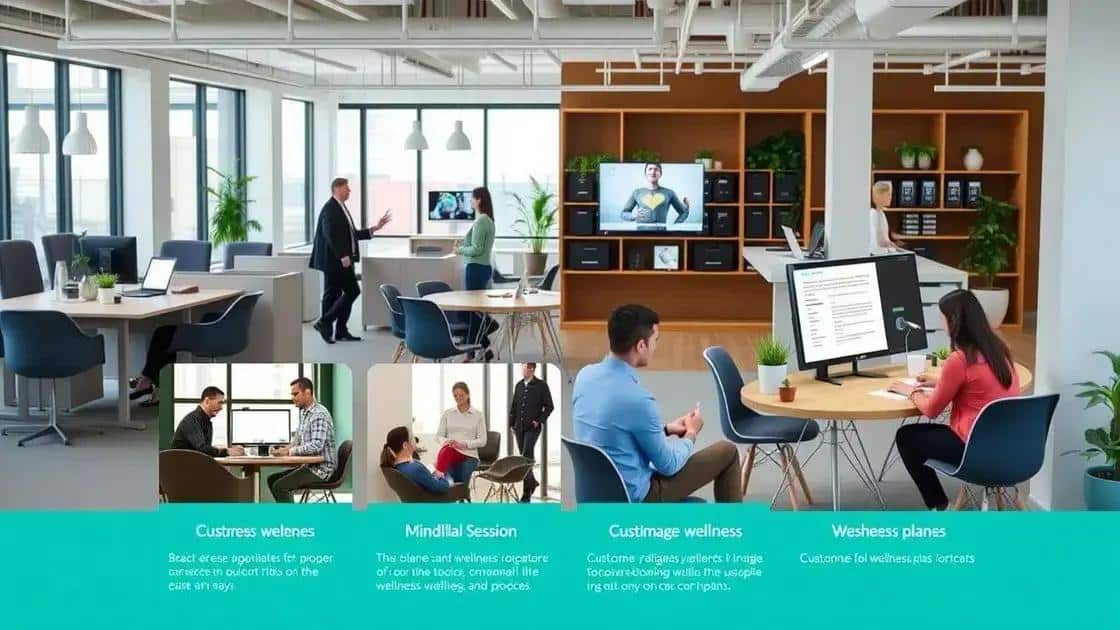Workplace burnout prevention trends: find your balance

Workplace burnout prevention trends emphasize the importance of open communication, mental health resources, work-life balance, and the use of technology to create a supportive environment for employees.
Workplace burnout prevention trends are becoming increasingly important in today’s fast-paced environment. Have you noticed how stress seems to be a constant companion for many employees? In this article, we’ll delve into effective strategies and insights to help organizations support their teams.
Understanding workplace burnout
Understanding workplace burnout is crucial for creating a healthy work environment. Burnout isn’t just about being tired; it’s a state of emotional, physical, and mental exhaustion caused by prolonged stress. Recognizing the signs early can help you address the issue before it escalates.
One common cause of burnout is excessive workload. Employees often feel pressured to meet tight deadlines or manage unrealistic workloads, leading to a sense of overwhelm. Other factors include lack of control over work tasks, insufficient rewards for effort, and a poor work-life balance.
Signs of burnout
Identifying burnout can be challenging, but there are several key indicators to watch for. These include:
- Chronic fatigue and exhaustion
- Increased irritability and frustration
- Decreased performance and productivity
- Feeling detached or cynical about work
It’s important to note that burnout can affect anyone, regardless of their position within a company. Even the most dedicated employees can reach a breaking point.
Impact of burnout on workplace culture
When burnout affects a team, it can severely impact workplace culture. A toxic environment can result in:
- Poor teamwork and collaboration
- High employee turnover
- Lower morale across the board
- Increased absenteeism
To combat burnout, companies must foster a supportive workplace culture. This includes encouraging open communication and promoting healthy work-life balance. Simple changes, like flexible working hours, can significantly decrease feelings of burnout.
Top strategies for prevention

Implementing strong strategies is essential for preventing workplace burnout. Organizations can take proactive steps to create a healthier environment and protect employee well-being.
Encourage open communication
Open communication is vital in preventing burnout. When employees feel they can speak up about their concerns, it fosters trust and collaboration. Regular check-ins can help managers identify potential stressors before they escalate.
- Create safe spaces for feedback
- Encourage team discussions about workload
- Utilize anonymous surveys for honest input
Furthermore, team leaders should model healthy communication practices themselves. Sharing challenges and seeking help when needed can set an example for everyone in the organization.
Promote work-life balance
A healthy work-life balance is crucial in the fight against burnout. Employers can support their teams by offering flexible work hours and encouraging employees to take regular breaks. When employees use their vacation time and unplug from work, they return feeling refreshed and energized.
- Implement flexible working hours
- Encourage regular breaks throughout the day
- Celebrate employee vacations and time off
Additionally, giving employees the tools to manage their time effectively can boost productivity, allowing them to complete their tasks without constant pressure.
Provide resources for mental health
Access to mental health resources plays a significant role in preventing burnout. Employers should consider offering counseling services or workshops on stress management and resilience.
- Offer access to therapy and counseling
- Host workshops on mindfulness and stress reduction
- Share resources on mental health support
By prioritizing mental health, employees are more likely to feel supported and valued, which in turn fosters a more engaged and productive workforce.
Role of leadership in burnout prevention
The role of leadership in burnout prevention is vital for creating a healthy workplace. When leaders prioritize employee well-being, it sets the tone for the entire organization. Strong leadership can drive positive change, helping to reduce burnout and promote a supportive work environment.
Modeling healthy behavior
Leaders should actively demonstrate healthy work-life balance and stress management practices. When employees see their managers taking breaks and practicing self-care, they are more likely to follow suit. It’s important for leaders to share their own experiences with stress and how they cope.
- Encourage regular breaks for employees
- Share personal stories of managing stress
- Promote work-life balance actively
By modeling these behaviors, leaders can help create a culture where taking care of one’s mental health is viewed positively.
Providing support and resources
Effective leaders provide the necessary resources to help employees manage stress. This includes not only mental health resources but also professional development opportunities. Investing in training can empower employees to handle their workloads more effectively and feel more competent in their roles.
- Offer access to mental health professionals
- Provide training on time management and productivity
- Encourage participation in wellness programs
Such initiatives foster a sense of support, making employees feel valued and understood.
Encouraging feedback and participation
Leadership should always encourage open dialogues regarding workplace issues. By actively seeking feedback, leaders can identify problems before they contribute to burnout. Creating forums for employees to express their thoughts can lead to significant improvements in work conditions.
- Host regular feedback sessions
- Implement employee suggestion programs
- Encourage team discussions on workload
When employees feel heard, it enhances their engagement and job satisfaction, making them less likely to experience burnout.
Future trends in workplace wellness

The future trends in workplace wellness are evolving, with a focus on holistic approaches to employee health. As companies recognize the importance of mental and physical well-being, innovative strategies are emerging to support their workforce.
Integration of technology
Technology is playing a significant role in enhancing workplace wellness. Apps for mental health, fitness tracking, and wellness challenges are becoming more common. Employers are using these technologies to promote healthy habits and monitor employee engagement.
- Virtual mental health platforms
- Fitness and wellness tracking applications
- Telemedicine for easy access to healthcare
The demand for these tools is expected to increase, helping employees maintain a balanced lifestyle both in and out of the office.
Focus on mental health
Mental health awareness has risen sharply, leading to a more supportive approach in the workplace. Companies are prioritizing mental health resources and programs, understanding that supporting mental well-being is crucial to reducing burnout.
- Workshops on stress management
- Access to therapy and counseling
- Mindfulness and meditation programs
By making mental health a priority, organizations can create a more resilient workforce that thrives in challenging situations.
Personalized wellness programs
Personalization is becoming a key feature in workplace wellness programs. Tailoring wellness initiatives to individual needs is more effective than one-size-fits-all solutions. Employees desire options that fit their personal health goals.
- Customizable fitness programs
- Nutritional counseling based on personal preferences
- Flexible work arrangements to accommodate different lifestyles
Companies that offer personalized options often see higher participation rates and better outcomes in employee wellness.
FAQ – Frequently Asked Questions about Workplace Burnout Prevention Trends
What are the common signs of workplace burnout?
Common signs include chronic fatigue, irritability, decreased performance, and a sense of detachment from work.
How can flexibility in the workplace help reduce burnout?
Flexible work arrangements allow employees to balance their work and personal lives better, reducing stress and improving overall well-being.
What role do managers play in preventing burnout?
Managers can create a supportive environment by promoting open communication, providing resources, and modeling healthy work habits.
How can technology support workplace wellness?
Technology can enhance wellness through apps for mental health, fitness tracking, and telehealth services, making resources more accessible to employees.





